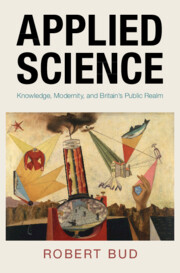767 results
Chapter 14 - Technologies of the Book
- from Part III - The Practical Arts
-
-
- Book:
- The Cambridge Companion to William Morris
- Published online:
- 03 May 2024
- Print publication:
- 23 May 2024, pp 188-200
-
- Chapter
- Export citation
AI-Inclusivity in Healthcare: Motivating an Institutional Epistemic Trust Perspective
-
- Journal:
- Cambridge Quarterly of Healthcare Ethics , First View
- Published online by Cambridge University Press:
- 29 April 2024, pp. 1-15
-
- Article
-
- You have access
- Open access
- HTML
- Export citation
25 - Communicative Gesturing in Interaction with Robots
- from Part V - Gestures in Relation to Interaction
-
-
- Book:
- The Cambridge Handbook of Gesture Studies
- Published online:
- 01 May 2024
- Print publication:
- 18 April 2024, pp 641-660
-
- Chapter
- Export citation
Chapter 13 - Extending Extension’s Outreach and Engagement with Social Media
- from Part III - Looking Ahead: Emerging Issues and Trends
-
-
- Book:
- Extension Education and the Social Sciences
- Published online:
- 28 March 2024
- Print publication:
- 04 April 2024, pp 267-285
-
- Chapter
- Export citation
A Folsom Foreshaft from the Blackwater Draw Site
-
- Journal:
- American Antiquity , First View
- Published online by Cambridge University Press:
- 02 April 2024, pp. 1-16
-
- Article
-
- You have access
- Open access
- HTML
- Export citation
Chapter 2 - Black Steam
- from Part I - Mechanical Automata
-
-
- Book:
- Victorian Automata
- Published online:
- 15 March 2024
- Print publication:
- 28 March 2024, pp 48-69
-
- Chapter
- Export citation
Chapter 13 - The Strange Career of Topsy
- from Part IV - Interactions
-
-
- Book:
- Victorian Automata
- Published online:
- 15 March 2024
- Print publication:
- 28 March 2024, pp 272-288
-
- Chapter
- Export citation
Introduction
-
- Book:
- Applied Science
- Published online:
- 15 March 2024
- Print publication:
- 28 March 2024, pp 1-16
-
- Chapter
- Export citation
3 - Competing Concepts of Applied Science and Technology
- from Stage 1 - Origins and Pedagogy in the Nineteenth Century
-
- Book:
- Applied Science
- Published online:
- 15 March 2024
- Print publication:
- 28 March 2024, pp 66-90
-
- Chapter
- Export citation
8 - From Applied Science to Technological Innovation
- from Stage 3 - After World War Two
-
- Book:
- Applied Science
- Published online:
- 15 March 2024
- Print publication:
- 28 March 2024, pp 226-254
-
- Chapter
- Export citation
Chapter 28 - Modernity
- from Part V - Culture and Society
-
-
- Book:
- Pirandello in Context
- Published online:
- 14 March 2024
- Print publication:
- 21 March 2024, pp 227-234
-
- Chapter
- Export citation
Leveraging national security: private equity and bankruptcy in the United States defense industry
-
- Journal:
- Business and Politics , First View
- Published online by Cambridge University Press:
- 18 March 2024, pp. 1-20
-
- Article
-
- You have access
- Open access
- HTML
- Export citation

Applied Science
- Knowledge, Modernity, and Britain's Public Realm
-
- Published online:
- 15 March 2024
- Print publication:
- 28 March 2024
37 - Education and the Technological Horizon
- from Part III - Emerging Ethical Pathways and Frameworks
-
-
- Book:
- The Cambridge Handbook of Ethics and Education
- Published online:
- 07 March 2024
- Print publication:
- 14 March 2024, pp 777-796
-
- Chapter
- Export citation
Chapter 2 - A Country Transformed, 1721–2024
-
- Book:
- The Impossible Office?
- Published online:
- 14 March 2024
- Print publication:
- 14 March 2024, pp 30-68
-
- Chapter
- Export citation
The triple glass ceiling: FinTech gender inequalities
-
- Journal:
- Finance and Society ,
- Published online by Cambridge University Press:
- 05 March 2024, pp. 1-20
-
- Article
-
- You have access
- Open access
- HTML
- Export citation
6 - Technology, 1000–1500
- from Section II - The Medieval Economy, 1000–1500
-
-
- Book:
- An Economic History of the Iberian Peninsula, 700–2000
- Published online:
- 22 February 2024
- Print publication:
- 29 February 2024, pp 158-174
-
- Chapter
- Export citation
14 - Science, Knowledge and Technology, 1500–1800
- from Part II - Globalization and Enlightenment, 1500–1800
-
-
- Book:
- An Economic History of the Iberian Peninsula, 700–2000
- Published online:
- 22 February 2024
- Print publication:
- 29 February 2024, pp 358-384
-
- Chapter
- Export citation
Perspectives on Communication Technology Use for Alleviating the Impact of COVID-19 on Hospitalized Patients’ Well-Being and Transitions in Care
-
- Journal:
- Canadian Journal on Aging / La Revue canadienne du vieillissement , First View
- Published online by Cambridge University Press:
- 19 February 2024, pp. 1-8
-
- Article
-
- You have access
- Open access
- HTML
- Export citation
Politics of creep: Latent development, technology monitoring, and the evolution of the Schengen Information System
-
- Journal:
- European Journal of International Security , First View
- Published online by Cambridge University Press:
- 13 February 2024, pp. 1-17
-
- Article
-
- You have access
- Open access
- HTML
- Export citation



